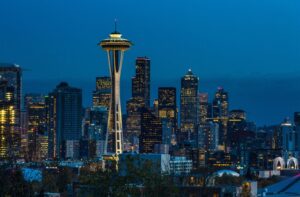Security Guards
Introducing the Expert Guide to Effective Crowd Management for Security Guards
Have you ever experienced a sense of unease in a densely packed event or a heavily crowded space? The presence of security guards often serves as a comforting reassurance in such situations. They are responsible for implementing effective crowd management measures. Security guards are responsible for instilling a feeling of safety in individuals. However, managing […]
By David Kerolles
July 5, 2023

Have you ever experienced a sense of unease in a densely packed event or a heavily crowded space? The presence of security guards often serves as a comforting reassurance in such situations. They are responsible for implementing effective crowd management measures.
Security guards are responsible for instilling a feeling of safety in individuals. However, managing large crowds takes a lot of work. The job of a security guard is to make people feel safe. But, it’s not easy to control a big crowd. Maintaining without causing panic is a huge challenge.
This guide presents useful tips and insights from experts in the security industry to equip security guards and provide the skills and knowledge they need.
Efficient Handling of Crowds
Security guards are at the front line. They control crowds and prevent possible dangers. Seeing security guards around can improve how people feel at big events like sports matches, music festivals, and large get-togethers.
This section aims to highlight the significance of having effective crowd-handling strategies, the definition of crowd control, and what makes crowd-management techniques effective.
Definition of Crowd Control
Crowd control is all about managing large groups of people. Proper crowd control management is a way to cope with social disorder, like showing authority or keeping a crowd in check.
The goals are simple – maintain order, protect people, and ensure things go as planned. To prevent any chaos or danger in a crowd, various strategies and precautions are used.
Security guards play a crucial role in this. They monitor the crowd, spot any potential issues, and step up when necessary. The prime aim is to ensure everyone’s safety. Dealing with all kinds of crowd management problems is part of a security guard’s training.
The Importance of Skillful Crowd Control Management
- Upholding public safety: crucial to crowd management is providing a secure environment for all participants. By executing adequate crowd handling strategies, security guards can detect and take care of potential risks like suspicious activities and medical crises.
- Preventing density: proper crowd control avoids overpopulation in busy areas, facilitating safe movement. This aids in eluding mishaps like stampedes and potentially dangerous situations in heavy crowds.
- Fast-response to Emergency: when a crisis hits, trained security guards respond fast to emergencies. They work with medical teams to assure safety. They lead people to first aid spots. They can handle emergency evacuations too.
- Better communication: communication matters during crowd control. Security guards use speakers and announcements to spread important updates, such as safety steps. This keeps every attendee informed and things running smoothly.
- Crowd-control: in charge of the entrance and crowd surveillance, the security team allows entry only to the authorized. This blocks unwanted access and ensures safety for all present. Drone surveillance can be utilized to assess the crowd and see the proper condition in a bird’s eye view.
Teamwork Matters: Security Guards Duties in Crowd Management
A team of security guards properly coordinated and instructed is critical in crowd management. Security guards should work together to monitor the crowd, respond to possible threats, and maintain order. A well-coordinated security team makes managing large events successful.
As a team, they should always be on high alert. Swiftly spotting and dealing with issues in a crowd, security guards can help run a smooth and successful event.
They can deter troublemakers and prevent harmful actions. And manage disturbances and quickly calm safety concerns.
Essential Crowd-Management Training for Security Guards
Security guards need crowd-management training for safe handling of big gatherings, events, or areas where many people collect. Here are crucial parts of the training that those guards need:
1. Understanding Crowd Dynamics
Security guards have to learn crowd movements and reactions. They need to spot any signs of trouble, grasp the psychology of the crowd, and know how different aspects, like weather or the event itself, alter crowd conduct.
2. Communication Skills
Clear and direct talk is a vital part of managing crowds. Guards need to know how to give out info and instructions and calm down possible fights. They should also be trained on how to use communication tools and work in sync with others.
3. Conflict Resolution
The training must show guards how to solve problems peacefully. They should learn to handle arguments, different ideas, or rowdy behavior in the crowd without needing to use force.
4. Emergency Response
Security guards must learn how to respond right in emergencies. This includes knowing where people should go in evacuations, first aid, and how to talk during emergencies. The training will walk them through how to guide crowds to a safe spot, give basic first aid, and work with emergency workers.
5. Access Control and Screening
Training must stress the need for reasonable access control. Security guards should be proficient at checking attendees, verifying tickets or credentials, and recognizing forbidden stuff. This stops unapproved access and helps keep the event safe.
6. Crowd Surveillance
Grasping how to monitor the crowd is critical for security guards. Training should teach the use of spying tools like CCTV cameras, watching crowd activity, and spotting possible threats. While patrolling and watching the crowd, guards need to stay alert.
7. Crowd-Handling Techniques
Training to manage crowds should factor in physical fitness and techniques for managing crowds safely. This is rooted in knowing how to move through thick crowds, regulate crowd movement, and deal with instances where physical interaction is needed.
If these key factors are part of crowd-management training, security guards will be better geared to handle significant crowd issues, adding to public safety and making events or group gatherings a success.
Communication Techniques for Crowd Management
Good chat skills are crucial for crowd control. Through good communication, security teams can make big gatherings like concerts, sports games, or festivals safe.
Let’s see how security guards can talk effectively with their team members and attendees for efficient crowd handling.
1. Good Talk System is a Must
A sound talk system is crucial for crowd handling. Security folks need gadgets, for example, radios or earpieces, to stay connected. When emergencies strike, this connection allows swift action. Regular chats and updates through the system keeps everyone clued in and ensure team harmony in crowd handling.
2. A Clear Ranking System is Key
A clear hierarchy is a must when lots of security staff are involved. This order promises smooth decision-making and teamwork. Every guard needs to know their duties in the hierarchy. Clear lines of command enhance communication and speedy response to crowd issues.
3. Regular Announcements and Use of Public Address Systems
Public address systems play a crucial role in controlling crowds. Through consistent announcements, security guards can provide important instructions, reminders, and updates to the attendees.
Clear announcements aid in maintaining order, guiding the crowd, and sharing imperative details such as emergency exits, first aid locations, and essential services. To ensure the crowd receives crucial direction, announcements need to be brief, informative, and easy to comprehend.
4. Importance of Good Communication in Security Staff Training
Proper training is critical for security guards to manage crowds effectively. This preparation should include clear speech, active listening, and delivering concise, straightforward directions.
It’s essential for guards to alter their communication style to address different crowds effectively. This guarantees that attendees receive appropriate information and comprehend the instructions from the guards.
Crowd Control Tips To Implement
The enormous task of keeping everyone safe while fostering peace can be daunting. This guide tackles the struggles security guards deal with in managing large crowds. Here are some crowd-control tips to implement to manage an event smoothly:
1. Planning Ahead
All big events need careful planning. Risks must be looked at to spot possible problems. Event planners must work with local authorities, emergency services, and critical people.
They need to form a solid crowd management strategy. It should be ready for all types of scenarios and emergencies, like crowd surges or surprise events. Good planning creates a robust base for handling crowds.
2. Talking Clearly and Using Signs
It’s vital to communicate clearly when controlling crowds. Signs throughout the events site can share crucial information and rules. Screens and loudspeakers can carry messages further.
Attendees should know what items are prohibited, know where to enter or exit, and how to evacuate in an emergency. Clear communication limits confusion and helps crowds flow smoothly.
3. Managing Entrances and Exits
Keeping an eye on people going in and out is critical to crowd control. Entry and exit points need to be managed. Barriers, revolving gates, or ticketing can help to control the crowd, stopping overcrowding and making entry orderly. Good entrance and exit control add to security and helps attendees have a well-organized experience.
4. Getting Tickets and Checking in
A simple ticket system and registration check-in help avoid big crowds at entries. Online tickets or sign-ups cut down waiting in lines and help people get in faster.
Security guards can use tech like barcode scans or RFID for checking tickets quickly and correctly. This makes managing crowds easier and quicker, and people don’t have to wait as long at the doors.
5. Safety Team
A trained, noticeable safety team spread out through the event area is essential to manage crowds. A safety team can stop potential problems and react quickly if there’s trouble.
They can guide crowd actions, enforce rules, and help visitors. If they have good communication tools, like walkie-talkies, they can work together quickly and in an orderly manner when needed.
6. Watching and Checking
It’s key to have a robust system for watching and checking on crowds. Using closed-circuit cameras (CCTV) throughout the event lets you immediately watch people and spot problems.
Security guards can use modern data analysis to check crowd number and pinpoint areas that might be risky. Being prepared and ready to act lets you change your crowd management techniques as needed, making sure your event is safe and secure.
7. Design for Audience Movement
Designing a venue for good crowd flow is vital. It prevents crowds from bunching up and keeps people moving quickly. You do this with well-marked paths, entrances and exits, and temporary barriers. These things make lines organized and fight against crowding. They knew when and where people would gather helps.
Security guards can design the venue to spread people out, get rid of problem areas, and keep everyone flowing smoothly.
8. Plan for Emergency Exit
An evacuation plan is a must-have for safety. It’s there in case something unexpected happens. Both staff and attendees need to understand the plan.
Holding drills regularly means everyone knows how to leave quickly and calmly. Choosing meeting points and making sure emergency vehicles can get in easily makes the plan work better. This way, potential emergencies are easier to handle.
All of these steps for crowd control work together. They make any space with a big crowd a safer, better-run place. Using all these strategies, not just one, makes for reasonable crowd control.
This means safer public spaces and a better time for attendees. After an event, looking at what worked and what didn’t is critical. It leads to better crowd control each time.
Conclusion
Thus, efficient crowd control enables security personguardsnel to maintain public safety. Following these tips, security officers can adeptly handle difficult crowd situations.
Through uninterrupted communication, security guards can distribute essential information to the crowd and their team, promoting order in potentially chaotic situations — also, crowd management techniques includes creating physical barriers and directing crowd movements.
Since mishandling crowd control happens occasionally and the blame is put on security, ensure your security guard company is insured. The security guard insurance cost is always worth the investment.
Related Posts
Emergency
The Crucial Role of Licensed Security Guards in Emergency Management In today’s unpredictable world, the importance of effective emergency management cannot be overstated. Licensed security guards serve as a critical component of emergency response systems, acting as the first line of defense during crises. Their presence not only minimizes potential damage but also ensures the […]
By David Kerolles
June 27, 2023
Safety
How do you as a company owner or manager address the important issue of your security personnel sleeping while on duty? Your first reaction to a sleeping security guard or sleeping security officer might be for their immediate dismissal. Your company is being paid for attentive and continuous security services to protect persons, places and […]
By Catherine Shannon
April 4, 2024
Security Guards
Private Military Contractor Salaries Revealed In 2025 Private Military Contractors are an integral part of a shadowy world of modern warfare, and unveiling their precise earnings is often difficult due to the secretive nature of this sector of the security industry. Salary details are part of classified information related to national security, military strategy, or […]
By Catherine Shannon
January 3, 2025






